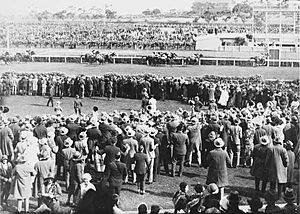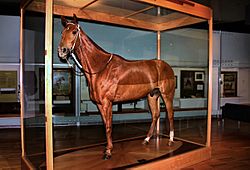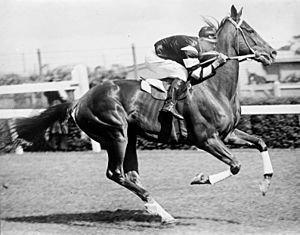Phar Lap facts for kids
Phar Lap (born October 4, 1926 – died April 5, 1932) was a super famous Thoroughbred racehorse. He became a hero to many people during the tough times of the Great Depression. Born in New Zealand, he was trained and raced in Australia by Harry Telford. Phar Lap was amazing at racing in Australia, winning the Melbourne Cup, two Cox Plates, an AJC Derby, and 19 other big races. His last race was in Mexico, where he won the Agua Caliente Handicap in record time. Sadly, he died suddenly and mysteriously in 1932 in California, USA. At that time, he was the third highest-earning racehorse in the world!
Today, you can see his preserved hide (skin) at the Melbourne Museum. His skeleton is at the Museum of New Zealand Te Papa Tongarewa, and his heart is on display at the National Museum of Australia in Canberra.
Contents
What's in a Name?
The name Phar Lap comes from a word in the Thai and Zhuang languages that means "sky flash" or "lightning."
People gave Phar Lap many nicknames, like the "Wonder Horse," "Red Terror," "Bobby," and "Big Red." He was sometimes called "Australia's wonder horse."
According to the Museum of Victoria, a student named Aubrey Ping suggested the name "farlap." He knew the word from his father, who was a Chinese immigrant. Harry Telford, Phar Lap's trainer, liked the name but changed the "F" to "PH." He also split the name into two words to match how many Melbourne Cup winners were named.
Phar Lap's Early Life
Phar Lap was a chestnut gelding, which means he was a male horse with a reddish-brown coat who was gelded (unable to have babies). He was born on October 4, 1926, in New Zealand. His dad was a horse named Night Raid, and his mom was Entreaty. He had the same dad as another Melbourne Cup winner, Nightmarch. Phar Lap had seven brothers and sisters, but none of them became famous racehorses like him.
Harry Telford, a trainer from Sydney, convinced an American businessman named David J. Davis to buy the young horse. Harry's brother, Hugh, bought Phar Lap for 160 guineas (an old type of money) at an auction in New Zealand. When the horse arrived in Australia, he looked a bit clumsy, had warts on his face, and walked awkwardly. Davis was very upset and didn't want to pay to train him!
Harry Telford wasn't a very successful trainer back then, and Davis was one of his few horse owners. To make Davis happy, Telford agreed to train Phar Lap for free. In return, he would get two-thirds of any money the horse won. Telford first leased the horse for three years and later became a joint owner with Davis.
Even though a winning racehorse could make a lot of money by having babies, Telford decided to geld Phar Lap. He hoped this would help the horse focus only on racing.
Phar Lap's Racing Career
Phar Lap didn't start his career well. He finished last in his very first race and didn't win any of his next three races. But then, on April 27, 1929, he won his first race, the Maiden Juvenile Handicap, with a young jockey named Jack Baker. After a few months, he started racing more and getting better. He came in second in a race on September 14, 1929, and people in the racing world started to notice him. He won the Rosehill Guineas on September 21, 1929, by a lot!
As Phar Lap became more famous, some people tried to stop him. On November 1, 1930, criminals even tried to shoot him after he finished his morning practice! Luckily, they missed. Later that same day, he won the Melbourne Stakes, and three days later, he won the Melbourne Cup as the favorite.

During his four years of racing, Phar Lap won an amazing 37 out of 51 races! This included the Melbourne Cup in 1930. In 1930 and 1931, he won 14 races in a row! From his win in the VRC St. Leger Stakes as a three-year-old until his last race in Mexico, Phar Lap won 32 out of 35 races. In the three races he didn't win, he came in second twice, and in the 1931 Melbourne Cup, he finished eighth because he was carrying a very heavy weight.
Phar Lap was owned by American businessman David J. Davis, who had leased him to Harry Telford. After their three-year lease ended, Telford had enough money to become a joint owner. Davis then decided to send Phar Lap to North America to race. Telford didn't agree with this, so he didn't go. Instead, Davis took Phar Lap's trusted helper, Tommy Woodcock, as the new trainer. Phar Lap traveled by boat to Mexico to race in the Agua Caliente Handicap, which had the biggest prize money ever offered in North American racing. Phar Lap won the race in record time! He was ridden by Australian jockey Billy Elliot, who had now won seven races with Phar Lap. After that, the horse was sent to a private ranch in California while his owner planned more races.
Phar Lap's Death
On April 5, 1932, Phar Lap's helper, Tommy Woodcock, found him in a lot of pain with a high fever. Within a few hours, Phar Lap died from bleeding. Doctors who examined him found that his stomach and intestines were inflamed. This made many people think he had been poisoned on purpose. Other ideas included accidental poisoning from bug spray or a stomach illness. It wasn't until the 1980s that doctors could properly identify the infection.
In 2000, horse experts looked at the reports from when Phar Lap died. They thought he probably died from a bacterial stomach infection called duodenitis-proximal jejunitis.

In 2006, scientists used special technology to study Phar Lap's hair. They said it was almost certain he was poisoned with a large amount of arsenic just hours before he died. This supported the idea that he was killed by American gangsters who didn't want him to win and cause them to lose money on bets. However, there's no real proof that criminals were involved.
A veterinarian from Sydney, Percy Sykes, believes poisoning was not the cause. He said that back then, arsenic was often given to horses as a tonic (a type of medicine). He thought this could explain the high levels of arsenic found. He even said that "90 percent of the horses had arsenic in their system" because it was so common.
In 2008, the Melbourne Museum shared new findings. Scientists analyzed six hairs from Phar Lap's mane. They found that in the 30 to 40 hours before Phar Lap died, he had taken in a huge dose of arsenic. They couldn't say where the arsenic came from, but it was easy to get back then.
However, in 2011, a newspaper article shared a different idea. A New Zealand physicist and information from Tommy Woodcock (Phar Lap's helper) suggested that Phar Lap was never given any arsenic tonic and that he died from an infection. Tommy Woodcock always said Phar Lap was drug-free.
But, Harry Telford's (Phar Lap's trainer) old tonic book, displayed in the Museum Victoria, has a recipe for a "general tonic" with arsenic as a main ingredient. It even says, "A great tonic for all horses." So, there are many ideas about why Phar Lap had so much arsenic in his body, and we may never know the real reason for his death.
Cultural Impact

After he died, Phar Lap's heart was given to a museum in Canberra, and his skeleton went to New Zealand's National Museum in Wellington. His hide (skin) was preserved by a taxidermist and is now shown in the Australia Gallery at the Melbourne Museum. The hide and skeleton were even displayed together in 2010 for a special event!
Phar Lap's heart was very special because of its size. It weighed about 6.2 kilograms (13.7 pounds), which is much bigger than a normal horse's heart, which is about 3.2 kilograms (7 pounds). His heart is now at the National Museum of Australia in Canberra, and it's the most popular thing visitors want to see! However, some people, like author Peter Luck, believe the heart on display is not really Phar Lap's. They say his heart was cut up during the autopsy, and the one on display might be from a different horse.
Many books and films have been made about Phar Lap, including the 1983 movie Phar Lap. There's even a song called "Phar Lap—Farewell To You."
Phar Lap was one of the first horses to be put into both the Australian Racing Hall of Fame and the New Zealand Racing Hall of Fame. He was also ranked as the 22nd best U.S. Thoroughbred champion of the 20th century by a famous horse magazine.
Phar Lap is seen as a national hero in both Australia and New Zealand. In 1978, he was honored on a postage stamp in Australia, and he's even mentioned in the Australian citizenship test. A large bronze statue of Phar Lap, costing $500,000, was revealed near his birthplace in Timaru in 2009.
Legacy
Phar Lap has a life-sized bronze statue at Flemington Racecourse in Melbourne.
There are also streets named after him, like "Pharlap Street" in Sydney, Australia, and "Phar Lap Grove" in New Zealand.
Images for kids



